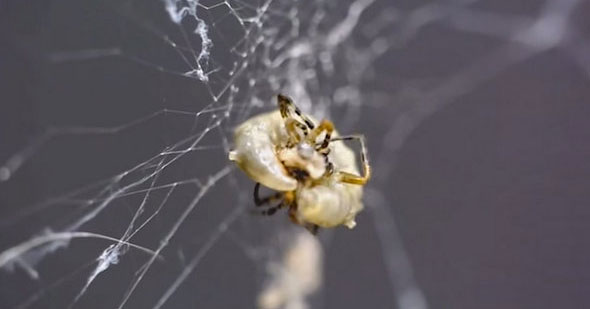The hornet larva attacks the spider's nervous system, meshes and creates cocoons
By robbing the spider's nervous system, a wasp larva was able to manipulate the animal to make it a more robust network, according to research published in The Journal. of Experimental Biology. Scientists believe that the Reclinervellus nielseni larvae process that controls the Cyclosa argenteoalba spider 's 'control organ' is not too complicated.
- New discovery of "bloodthirsty" parasitic insects
- How do hornets turn spiders into zombies?
The hornet larvae attack the spider's nervous system and create strong cocoons
First, an adult female bee must attack a spider so it can lay eggs on the spider's abdomen. When the eggs hatch, the larvae feed themselves by sucking the plasma of the spider. And perhaps this is the period of invasion of the mind that begins to happen; The researchers thought that the larvae had 'injected ' the spider with substances that changed its network building behavior. Therefore, as the larvae grew, it directed the spider to create a special kind of net. As soon as the mission is complete, the larvae kill the spider, using a pre-existing net to form a cocoon, which can help it hibernate for about 10 days, before reaching adulthood.

The hornet larva attacks the spider
Of course, the durability of the network can be quite random, according to Sophie Labaude, an ecologist at the University of Burgundy (France). She said that if the larvae actually formed cocoons by injecting chemicals into the spider's body, these chemicals themselves, with the right amount, blended into the spider's natural hormones, thereby creating the different. And because research is done in the laboratory, it's hard to know what the outcome will be if the process takes place in nature. Overall, Sophie said the study was really interesting and it was suggestive.
The Verge said this strange relationship was discovered by scientists 15 years ago, but until now, the mystery behind the nature of the new network has gradually been revealed. Accordingly, the net that the spider created after being seized control of itself is very similar to the type of net that this species often uses during molting. However, it is not a copy, as evidenced by the much stronger new network. Because of that, the new wasps are decided to lay eggs on the spider's abdomen, to ensure maximum safety for the next generation.

The larvae of the larvae are made more and more solid
In the animal world there are many interesting relationships like that found. For example, scientists have identified the type of ants that make ants "slaves" then eat their own children. Or Killifish flukes exist and reproduce within the fish's skull, then dominate the swimming behavior of this species, making it easier to catch by other predators like birds.
In general, most of these relationships have one characteristic, that is, scientists are still unable to explain why they are so. Keizo Takasuka - biologist at Kobe University (Japan) and co-author of the study said: 'Although we can reveal why bee larvae take control of spiders. But how did it do that is still a question mark '.
- Super small scouting helicopter
- What is 'monster larva' actually?
- Genetic contact between the immune system and the nervous system
- Detecting pollution dust attacking the brain
- Intelligent transistors simulate the nervous system
- Spider silk is used for electronic computer chips
- Use a lot of toothpaste that is dangerous to the nervous system
- Spiders re-solidify and birds
- Science has proven: Spider is a friend, not an enemy!
- Many new and rare spiders are found in Australia and India
- Science determines the time when spiders are most likely to occur in the home
- Why women are afraid of spiders?
 Why do potatoes have eyes?
Why do potatoes have eyes? 'Tragedy' the world's largest carnivorous life: Death becomes ... public toilet
'Tragedy' the world's largest carnivorous life: Death becomes ... public toilet Tomatoes were once considered 'poisonous' for 200 years
Tomatoes were once considered 'poisonous' for 200 years Detecting microscopic parasites on human face
Detecting microscopic parasites on human face Showing off a photo of a mini 'watermelon', the couple was unexpectedly praised by experts for their luck
Showing off a photo of a mini 'watermelon', the couple was unexpectedly praised by experts for their luck  Spiders can lure male fireflies into their nets with their 'love calls'
Spiders can lure male fireflies into their nets with their 'love calls'  Darwin's bark spider spins silk to 'build a bridge' 25m long
Darwin's bark spider spins silk to 'build a bridge' 25m long  'Army' of thousands of crabs stacked under the sea
'Army' of thousands of crabs stacked under the sea  Being 'pregnant' but not pregnant, dubbed a creature from hell but it's harmless
Being 'pregnant' but not pregnant, dubbed a creature from hell but it's harmless  The strangest spider on Earth: Not living in trees, but preferring to dive into the water, weaving silk to catch fish to eat
The strangest spider on Earth: Not living in trees, but preferring to dive into the water, weaving silk to catch fish to eat 